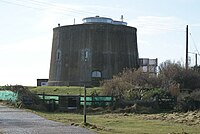Shingle Street
| Shingle Street | |
|---|---|
 Shingle Street in January 2008. | |
Location within Suffolk | |
| Civil parish | |
| District | |
| Shire county | |
| Region | |
| Country | England |
| Sovereign state | United Kingdom |
| Post town | WOODBRIDGE |
| Postcode district | IP12 |
| Police | Suffolk |
| Fire | Suffolk |
| Ambulance | East of England |
| UK Parliament | |

2miles
Shingle Street is a coastal settlement on the North Sea coast of the English county of Suffolk. It is 8 miles (13 km) north-east of Felixstowe and 12 miles (19 km) east of Ipswich at the mouth of the River Ore and opposite the tip of Orford Ness. It is within the parish of Bawdsey, with HM Young Offender Institution Hollesley Bay Colony nearby. A report from October 2004 suggests that Shingle Street is at risk from coastal erosion and flooding and could disappear within 20 years if sea defences are not erected.[2]
History
[edit]Shingle Street was originally a home for fishermen and river pilots for the River Ore. Early in the 19th century a Martello tower was built, which was later a home for coastguards. Many of the original buildings date from this period. A public house called the Old Beach House had been built here out of drift wood. Richard Cobbold mentions that in 1797 this public house being kept by Jacob Merrells who was also a pilot.[3] However, in 1810 this was replaced by a pre-fabricated wooden building built in Ipswich in the yard of the Cliff Brewery. It was then brought to Shingle Street by barge and named the Lifeboat Inn.[4] The pub was one of 300 pubs owned by Cobbolds Brewery and was pictured in Souvenir of the Bi-Centenery of the Cliff Brewery in Ipswich.[5]
World War II
[edit]Several buildings were destroyed during World War II, including the Lifeboat Inn.
After World War II many strange happenings were reported to have taken place at Shingle Street, including a failed German invasion.[6][7][8] Since the civilian population had been evacuated in May 1940, there were no eyewitness reports, although official documents remained classified until questions in the House of Commons led to their early release in 1993.[9] These papers disclosed no German landing. Rumours of a failed invasion on the South and East Coasts were commonplace in September 1940 and helped to boost morale. Author James Hayward has proposed that these rumours, which were widely reported in the American press, were a successful example of black propaganda with an aim of ensuring American co-operation and securing lend lease resources by showing that the United Kingdom was capable of successfully resisting the German Army.[10]
Shingle Street in culture
[edit]Shingle Street was the inspiration of the Thomas Dolby song "Cloudburst at Shingle Street", from the 1982 album The Golden Age of Wireless. Shingle Street and its Martello Tower are settings of Neil Spring's 2020 novel "The Haunted Shore".
The Shingle Street Shell Line
[edit]
In 2005 stonecutter Lida Cardozo Kindersley and her childhood friend Els Bottema started to arrange a line of shells on the beach, beginning as a way of coping with their shared experience of cancer treatment. After regular visits to add to the line by 2018 it stretched for more than 275m and was made up of 20,000 individual whelk shells.[11] A short documentary film about the work, entitled 'C shells', was released in 2017, followed by a book The Shingle Street Shell Line in 2018.[12][13]
- Views of Shingle Street
-
Coastguard cottages, Shingle Street
-
The Martello tower
-
Percolation lagoon at Shingle Street
References
[edit]- ^ "Orfordness Visitor Map" (PDF). National Trust. 2018. Retrieved 19 November 2018.
- ^ "Shingle Street". Archived from the original on 24 December 2007.
- ^ Miller, Tim (2016). Life on the edge : a brief history of Shingle Street. Shingle Street, Suffolk. ISBN 9780993593314.
{{cite book}}: CS1 maint: location missing publisher (link) - ^ Cobbold, Anthony (2017). "The Lifeboat Inn, Shinge Street" (PDF). Cobwebs: News and Views (November 2017). Ivybridge, Devon: The Cobbold Family History Trust.
- ^ Walton, Felix (1923). Souvenir of the Bi-Centenery of the Cliff Brewery in Ipswich. Ipswich: The Bi-Centenery of the Cliff Brewery in Ipswich Fete Committee.
- ^ Hayward, James (28 May 2001). The Bodies on the Beach: Sealion, Shingle Street and the Burning Sea Myth of 1940. CD41 Publishing. p. 18. ISBN 0-9540549-0-3.
- ^ "1940: The Secret War at Shingle Street". Ronald Ashford. 7 November 2007. Retrieved 23 September 2007.
- ^ Hayward, James (2 October 2002). "The Bodies on the Beach". BBC News. Retrieved 23 September 2007.
- ^ Hansard Debates. House of Commons. 19 February 1993.
- ^ Hayward, James (2002). Shingle Street. CD41 Publishing. ISBN 0-9540549-1-1.
- ^ "Shingle Street shell line inspired by friends' cancer treatment". www.bbc.co.uk. 17 March 2018. Retrieved 2 June 2019.
- ^ "C shells". outhousefilmworks.uk. 16 May 2018. Retrieved 2 June 2019.
- ^ "Suffolk Shorts: East Anglian Stories - First Light Festival". firstlightlowestoft.com. Retrieved 25 August 2019.
Further reading
[edit]- Johnson, Derek E (1992). East Anglia at War 1939-1945. Jarrold Publishing. ISBN 978-0-7117-0598-2.
External links
[edit] Media related to Shingle Street at Wikimedia Commons
Media related to Shingle Street at Wikimedia Commons




